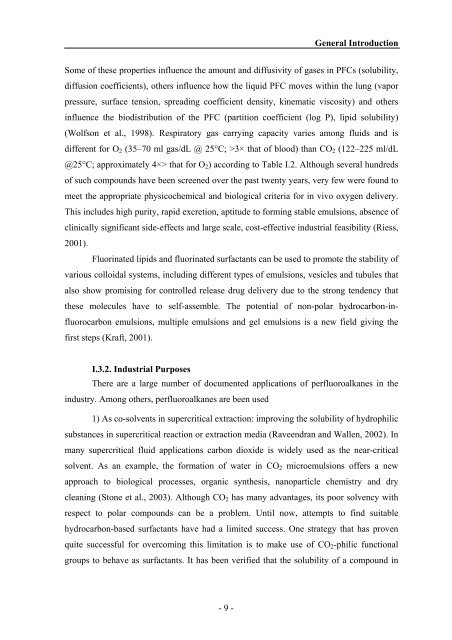n - PATh :.: Process and Product Applied Thermodynamics research ...
n - PATh :.: Process and Product Applied Thermodynamics research ...
n - PATh :.: Process and Product Applied Thermodynamics research ...
You also want an ePaper? Increase the reach of your titles
YUMPU automatically turns print PDFs into web optimized ePapers that Google loves.
General Introduction<br />
Some of these properties influence the amount <strong>and</strong> diffusivity of gases in PFCs (solubility,<br />
diffusion coefficients), others influence how the liquid PFC moves within the lung (vapor<br />
pressure, surface tension, spreading coefficient density, kinematic viscosity) <strong>and</strong> others<br />
influence the biodistribution of the PFC (partition coefficient (log P), lipid solubility)<br />
(Wolfson et al., 1998). Respiratory gas carrying capacity varies among fluids <strong>and</strong> is<br />
different for O2 (35–70 ml gas/dL @ 25°C; >3× that of blood) than CO2 (122–225 ml/dL<br />
@25°C; approximately 4×> that for O2) according to Table I.2. Although several hundreds<br />
of such compounds have been screened over the past twenty years, very few were found to<br />
meet the appropriate physicochemical <strong>and</strong> biological criteria for in vivo oxygen delivery.<br />
This includes high purity, rapid excretion, aptitude to forming stable emulsions, absence of<br />
clinically significant side-effects <strong>and</strong> large scale, cost-effective industrial feasibility (Riess,<br />
2001).<br />
Fluorinated lipids <strong>and</strong> fluorinated surfactants can be used to promote the stability of<br />
various colloidal systems, including different types of emulsions, vesicles <strong>and</strong> tubules that<br />
also show promising for controlled release drug delivery due to the strong tendency that<br />
these molecules have to self-assemble. The potential of non-polar hydrocarbon-in-<br />
fluorocarbon emulsions, multiple emulsions <strong>and</strong> gel emulsions is a new field giving the<br />
first steps (Kraft, 2001).<br />
I.3.2. Industrial Purposes<br />
There are a large number of documented applications of perfluoroalkanes in the<br />
industry. Among others, perfluoroalkanes are been used<br />
1) As co-solvents in supercritical extraction: improving the solubility of hydrophilic<br />
substances in supercritical reaction or extraction media (Raveendran <strong>and</strong> Wallen, 2002). In<br />
many supercritical fluid applications carbon dioxide is widely used as the near-critical<br />
solvent. As an example, the formation of water in CO2 microemulsions offers a new<br />
approach to biological processes, organic synthesis, nanoparticle chemistry <strong>and</strong> dry<br />
cleaning (Stone et al., 2003). Although CO2 has many advantages, its poor solvency with<br />
respect to polar compounds can be a problem. Until now, attempts to find suitable<br />
hydrocarbon-based surfactants have had a limited success. One strategy that has proven<br />
quite successful for overcoming this limitation is to make use of CO2-philic functional<br />
groups to behave as surfactants. It has been verified that the solubility of a compound in<br />
- 9 -



